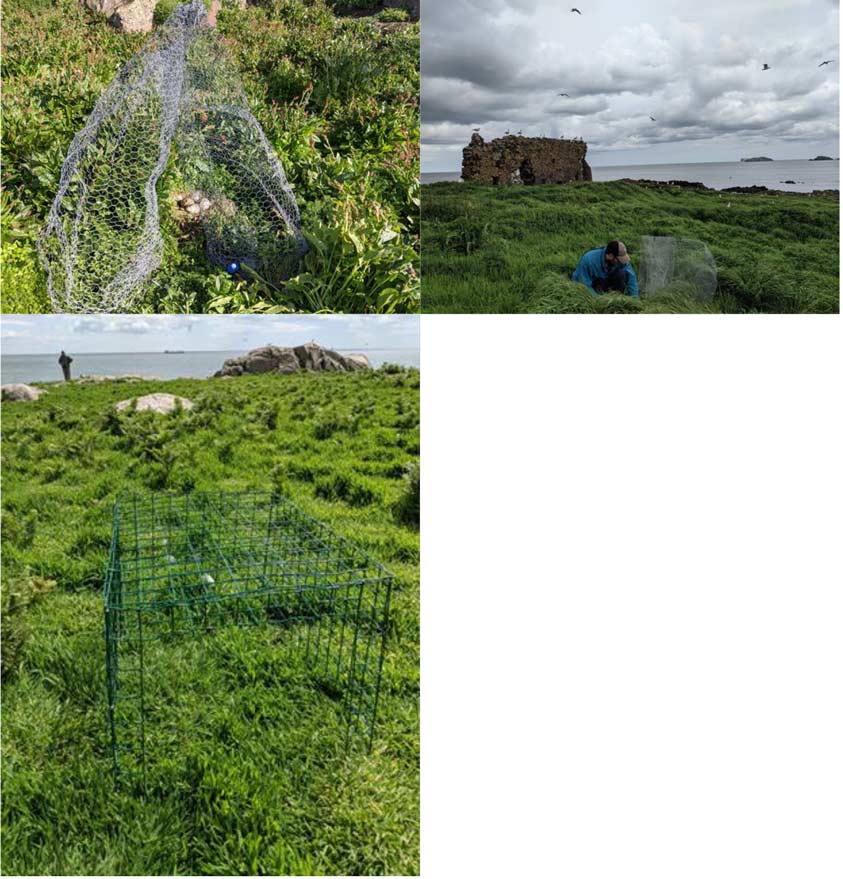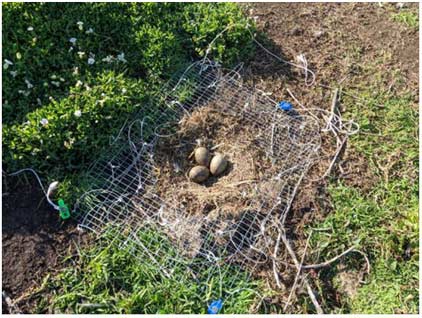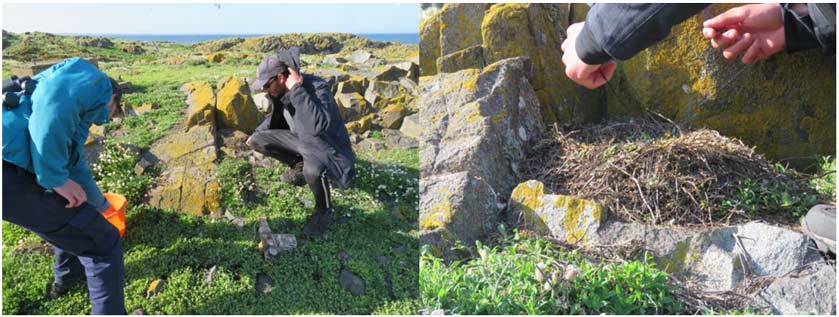Offshore wind energy - sectoral marine plan: seabird tagging feasibility
How to undertake a seabird tagging study for species and colonies potentially impacted by the sectoral marine plan for offshore wind energy
Capture methodologies
Most methods to capture seabirds at the breeding sites have been long established and are covered under conventional methods on a BTO ringing permit. More details can be found in Bub (1991) and Davis (1981). The most likely methods to be used for the relevant species in the proposed study are outlined below. All images relate to fieldwork carried out under license.
Noose pole
Suitable species: Guillemot, Razorbill, Kittiwake, Gannet
For species that sit tight to the nest or ledge when approached, a noose pole is likely the most effective method to capture them (Figure 3). This consists of a long pole with a single nylon noose secured to the end which is slowly placed over the head of the target bird and constricts as it is pulled tight or the bird flies off. The ringer can then quickly guide the bird to the ground, where the same or a second person may be waiting, to get the bird under control and extract from the noose. The type of noose used is not self-tightening, i.e. relaxes when not under pressure, and birds are typically restrained by the noose for <20 seconds so this method does not cause any harm. Seabirds also have very strong necks compared to most birds allowing safe use of this method.
Telescopic fishing poles are very suitable as they are easy to transport, strong and flexible. Poles up to 12m in length may typically be used but become more difficult to handle at greater lengths. The positioning of the noose on a 90° angle on the end may be helpful when catching birds sitting further back on ledges.
Noose poles may be operated from above or below cliffs. If working from above, immediately close to the edge, it is recommended that personnel are trained and competent to secure an anchor point and work off a rope and harness. It both makes the catching safer to undertake and may increase the number of birds which can be accessed safely.

Hook / Crook
Suitable species: Guillemot, Razorbill, Gannet
Various hooks may also be used in a similar manner to noose poles. These are typically shorter and with a fixed hook on the end of a suitable width for the target species to restrain them either by the leg or neck. Hooks are very simple and effective when used in colonies where you can approach birds nesting on level ground such as Gannets, or auks nesting in boulders.
Fleyg net
Suitable species: Guillemot, Razorbill (in flight)
Fleyg nets consist of a triangular net mounted on to a hand held pole, typically 2-3m in length, and can be very effective at some sites for catching birds in flight. These are often used to capture auks in dense nesting areas around cliff tops. Since birds are captured in flight, a disadvantage is that it is unclear where the nest sites of captured individuals are, which may be important for subsequent monitoring or recapture if required, or indeed whether they are active, breeding individuals.
Purse net
Suitable species: Guillemot, Razorbill, Puffins (in crevices/boulders/burrows)
Purse nets are not commonly used, and do require an additional SMTP license, but may be effective in some situations. These nets are secured over holes or burrows and entangle the bird as they arrive or leave. Typically more effective for burrow nesting species but may be used for boulder nesting auks of interest in this study.
Walk-in trap
Suitable species: Herring Gull, Great Black-backed Gull
A variety of designs of trap may be used and secured over the nest, including a passive circular design with a funnel entrance or a box (Potter trap) design with a door which closes once the bird enters the trap, either triggered directly by the bird or remotely by the ringer. Walk-in traps can be very effective as birds continue to incubate their eggs once inside the trap and are unaware they are caught until disturbed so multiple traps can be placed at once (Figure 4). Traps do not catch on every attempt though and timing and placement are important. Different designs can also easily be used in different habitats with different substrates, i.e. there are options to secure them on rock as well as grass (Figure 4).
If set correctly, there is an extremely low risk of damage to the eggs from the adults trying to escape before being extracted but it is also possible to temporarily replace the clutch with dummy eggs for the trapping period to ensure no damage is caused.
These traps have been regularly used for Herring Gull and while they can work for Great Black-backed Gulls, this species is typically much more wary of novel objects around the nest and the other methods described below may be more effective.

Spring trap/Bow net
Suitable species: Herring Gull, Great Black-backed Gull
Large spring traps or bow nets may also be used to catch gulls on the nest and consists of a spring-loaded net on a frame secured flat to the ground. Their placement is similar to walk-in traps, going directly over an active nest and waiting for the target bird to incubate. It is best to be actively triggered by the ringer to ensure it is safe as the frame of the trap moves with considerable force and has potential to cause injury.
Noose carpet
Suitable species: Herring Gull, Great Black-backed Gull
This method requires an additional SMTP license. Noose carpets consist of a section of wire mesh which is covered in numerous overlapping nylon nooses. Flat square sections or circular designs may be placed near or over nests, or any area birds are likely to walk through. The noose carpets need to be well secured and observed so a bird can be extracted as soon as it becomes entangled.

Single noose
Suitable species: Herring Gull, Great Black-backed Gull, Kittiwake
A single noose made of lightweight synthetic string may also be used to trap birds on the nest, this requires an additional SMTP license but is particularly useful in situations where trapping equipment needs to be discrete. This method has been used successfully for Great Black-backed Gulls in particular but also other gulls including Kittiwake. A single noose can be spread over the nest cup and pulled tight once the bird has settled, temporarily restraining it until it can be extracted. The single noose may be operated by hand or via a remote operated pull cord held under tension on a trigger pin. The latter option is beneficial as the capture is more rapid and effective but also more complicated due to the additional components that must be considered when setting.

Whoosh/cannon net
Suitable species: Herring Gull, Great Black-backed Gull
These methods require an additional SMTP license. Both whoosh and cannon nets are widely used to capture birds on the ground and operate by launching a net over a target area either using bungees or projectiles fired from cannons with explosive black powder, respectively. Neither method is regularly used for seabirds in breeding areas but could be effective for gulls at loafing spots or at pre/post breeding aggregations on fields, pools or beaches etc.
Contact
Email: ScotMER@gov.scot
There is a problem
Thanks for your feedback